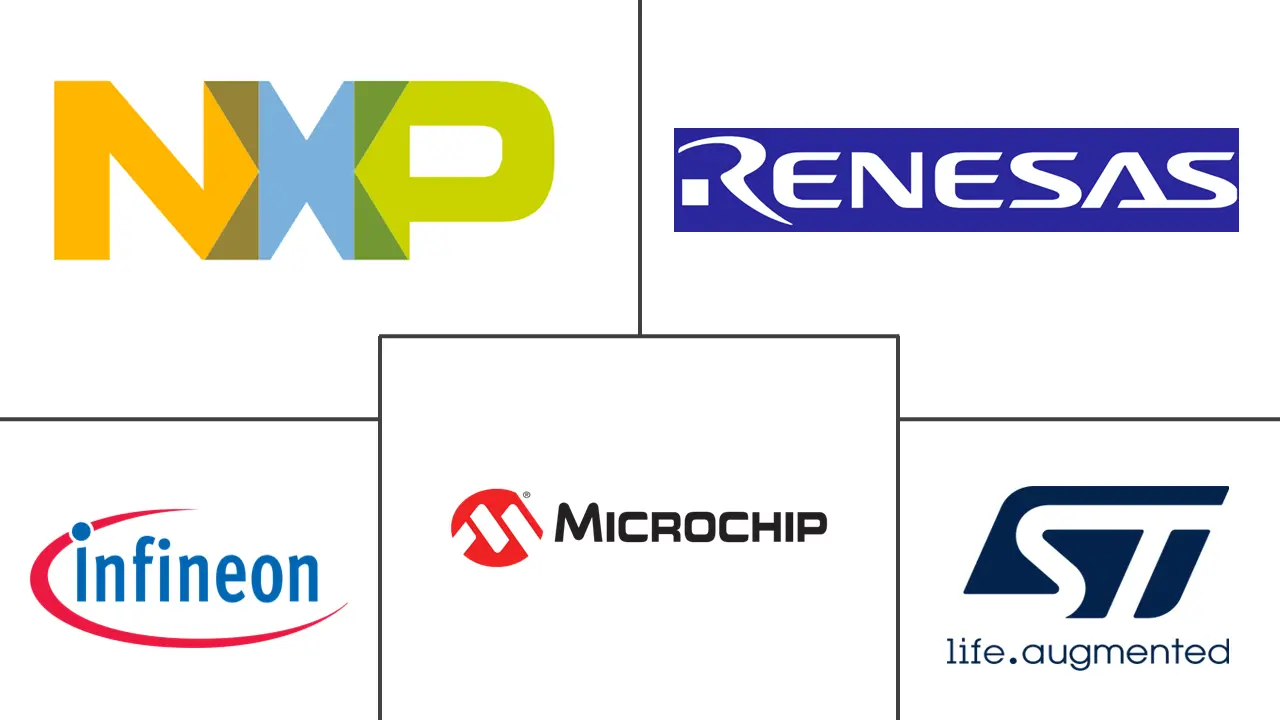Smartcard MCU Market Size and Share
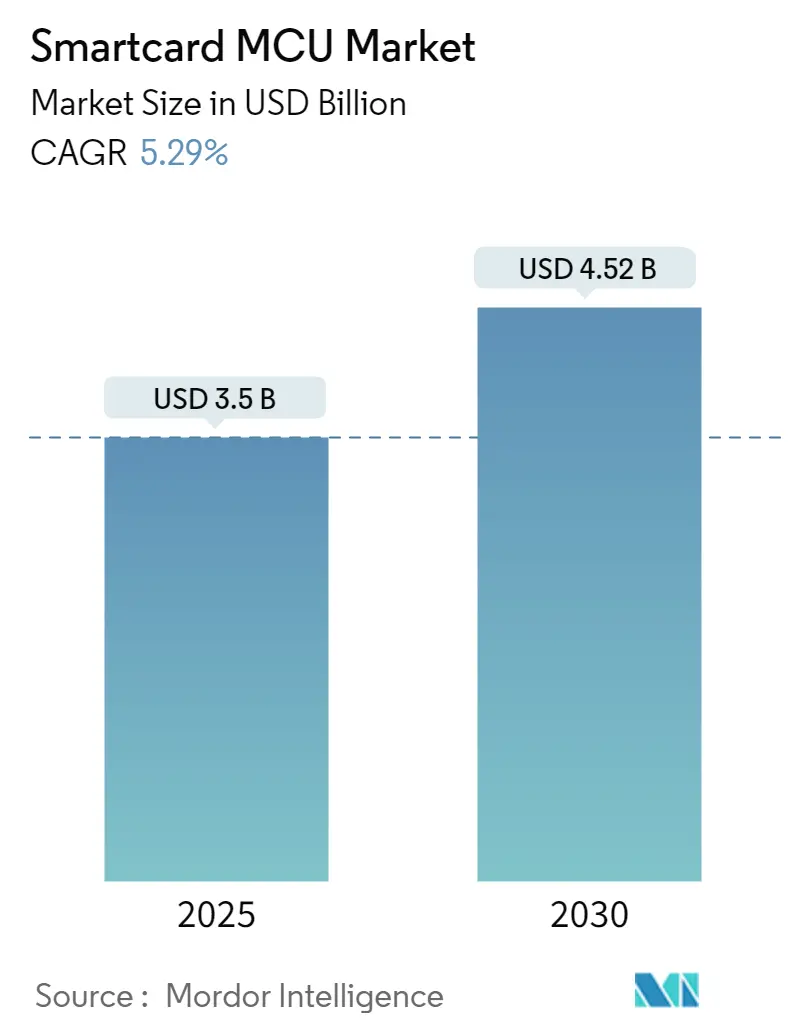
Smartcard MCU Market Analysis by Mordor Intelligence
The Smartcard MCU Market size is estimated at USD 3.50 billion in 2025, and is expected to reach USD 4.52 billion by 2030, at a CAGR of 5.29% during the forecast period (2025-2030). In terms of shipment volume, the market is expected to grow from 9.32 billion units in 2025 to 15.53 billion units by 2030, at a CAGR of 10.74% during the forecast period (2025-2030).
The smart card industry is experiencing a significant transformation driven by the increasing adoption of digital payment solutions and evolving consumer preferences. According to Forbes, over 53% of Americans now prefer digital wallets over traditional payment methods, with more than 70% indicating they would make digital wallets their primary shopping method. This shift has catalyzed innovations in smart card technology, particularly in the integration of advanced security features and the development of hybrid solutions that combine physical and digital payment capabilities. The emergence of biometric authentication and contactless payment technologies has further accelerated the evolution of smart card microcontrollers, enabling more secure and convenient transaction processes.
The convergence of multiple functionalities within single smart card solutions has become a prominent trend, with cards now serving various purposes beyond traditional payment applications. Smart cards are increasingly being deployed for identification, access control, transportation, and healthcare applications, driving the need for more sophisticated microcontroller units. The integration of near-field communication (NFC) technology has expanded the capabilities of smart cards, enabling seamless interaction with mobile devices and payment terminals. In China, this digital transformation is particularly evident, with mobile payment users reaching 943.19 million in the first half of 2023, demonstrating the growing acceptance of advanced payment technologies.
Security and miniaturization continue to be pivotal factors shaping the smart card MCU landscape. The latest generation of smart cards incorporates full on-chip cryptography and advanced security features, addressing the growing concerns about data protection and fraud prevention. The industry has witnessed significant advancements in form factor innovation, with smart cards being miniaturized into various formats such as mini-tags and smart wearables, catering to diverse user preferences and application requirements. This evolution has been particularly notable in the banking sector, where in January 2023, India recorded over 140 million point-of-sale transactions via credit cards, highlighting the increasing penetration of smart card technology.
The emergence of EMV chip technology has revolutionized the payment card industry, establishing new standards for security and functionality. Most new EMV cards now feature near-field communication capabilities, enabling contactless transactions while maintaining robust security protocols through dual verification processes. The integration of biometric authentication within smart cards represents another significant advancement, with manufacturers developing solutions that incorporate fingerprint sensors and other biometric capabilities. This trend is particularly evident in the financial sector, where banks are increasingly adopting biometric payment cards to enhance security while improving user experience.
Global Smartcard MCU Market Trends and Insights
RAPID DEVELOPMENT OF DIGITAL TECHNOLOGIES
The accelerating development of digital technologies has become a fundamental driver of the smart card MCU market, particularly in the realm of contactless and secure payment solutions. Smart cards equipped with advanced MCUs provide superior security compared to traditional magnetic stripe cards, as they can process data directly without remote connections. The integration of Radio Frequency Identification (RFID) technology and Near Field Communication (NFC) has significantly enhanced the functionality of smart cards, leading to increased adoption across various sectors. For instance, in August 2022, ICICI Bank collaborated with the National Payments Corporation of India to launch contactless credit cards on the RuPay network, while Mastercard introduced advanced technology-enabled contactless cards with enhanced cybersecurity features in October 2022.
The enhancement of smart cards with facial recognition technology and EMV chip capabilities has further accelerated their adoption in banking, financial institutions, retail, healthcare, and other industries. The penetration of high-end SIM cards and advanced communication technologies such as 5G has created new opportunities for Smart Card MCUs. According to Ericsson, 5G mobile subscriptions are expected to reach 1.5 billion globally by the end of 2023. This growth is supported by innovations such as STMicroelectronics' ST4SIM-201 embedded SIM launched in June 2022, specifically designed for machine-to-machine communication with compatibility for M2M security, 5G network access, and remote management capabilities.
INCREASING INVESTMENTS BY GOVERNMENTS IN TRANSPORTATION SYSTEMS
Government investments in transportation infrastructure and digital transformation initiatives have emerged as a significant driver for the smart card MCU market. The implementation of smart card technology in transportation systems has revolutionized payment methods and improved operational efficiency. In September 2023, the Delhi Metro launched special Tourist Smart Cards providing unlimited rides across the metro network, demonstrating the growing adoption of smart card solutions in public transportation. Similarly, various European cities have implemented innovative schemes, such as Malta's introduction of free public transport for smart card holders and the Netherlands' deployment of a comprehensive contactless transit payment system.
The substantial financial commitments from governments worldwide have created extensive opportunities for smart card MCU applications. India has allocated USD 1.4 trillion for infrastructure development until 2025, while the European Union has invested EUR 6.2 billion in safe and efficient transport infrastructure. China's fixed investment in transportation reached CNY 3.8 trillion (USD 537 billion) in 2022. These investments are complemented by technological advancements, such as the implementation of facial artificial intelligence mechanisms for access control, as demonstrated by India's new parliament building inaugurated in May 2023. The integration of SCOSTA (Smart Card Operating System for Transport Applications) in government buildings and critical infrastructure further emphasizes the growing importance of smart card MCUs in modern transportation systems.
Segment Analysis: By Product
32-bit Segment in Smart Card MCU Market
The 32-bit microcontroller segment dominates the smart card MCU market, commanding approximately 60% market share in 2024, driven by its superior processing capabilities and enhanced security features. These MCUs are particularly well-suited for high-security applications, offering more processing power and memory compared to 8-bit and 16-bit alternatives. The segment's prominence is further strengthened by its extensive application in banking smart cards, particularly in biometric authentication implementations. The 32-bit MCUs' ability to process larger volumes of data and support sophisticated security protocols has made them the preferred choice for modern smart card applications. Their enhanced features include support for multiple applications, advanced secure element cryptographic algorithms, and superior performance in contactless payment scenarios. The segment's growth is being fueled by increasing demand for secure payment solutions and the rising adoption of biometric smart cards across various industries.
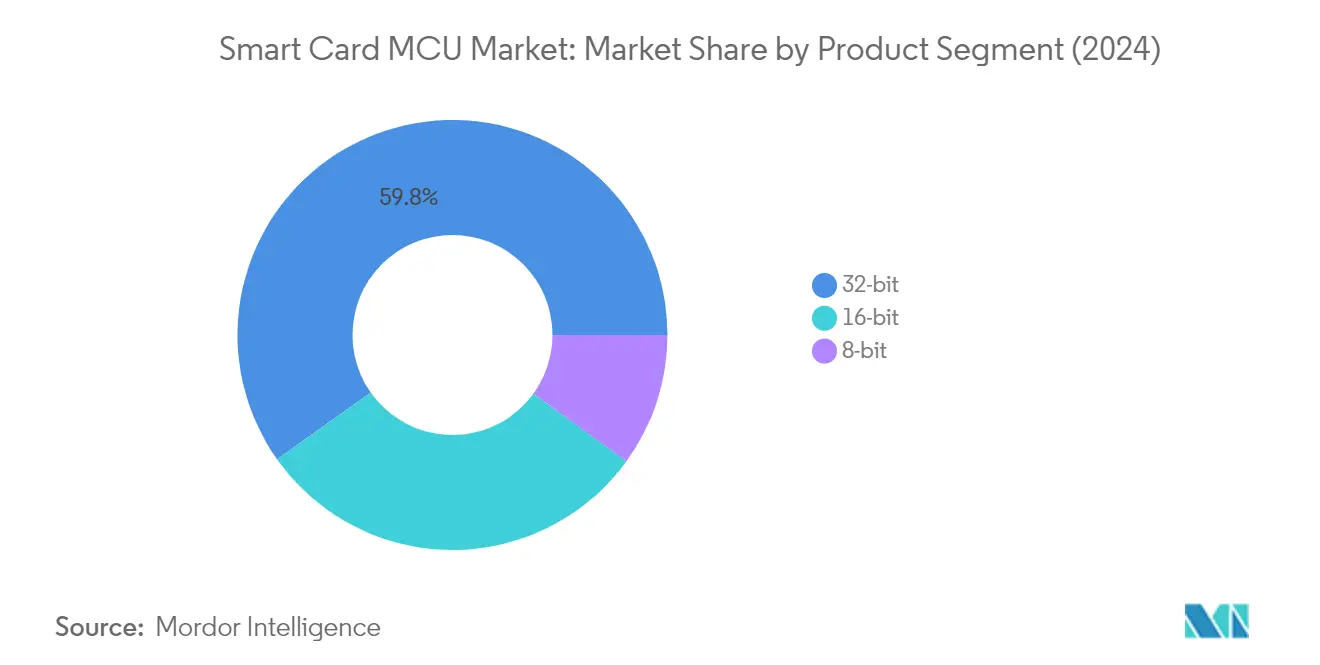
Remaining Segments in Smart Card MCU Market
The 16-bit and 8-bit segments continue to play important roles in the smart card MCU market, particularly in applications where cost-effectiveness and power efficiency are primary considerations. The 16-bit MCUs serve as a middle-ground solution, offering a balance between processing capability and power consumption, making them suitable for applications that don't require the full processing power of 32-bit MCUs. Meanwhile, 8-bit MCUs maintain their relevance in low-end applications where minimal processing power is needed, such as in battery-powered smart card readers. These segments are particularly important in emerging markets and cost-sensitive applications where the advanced features of 32-bit MCUs may not be necessary. The continued presence of these segments ensures that manufacturers can offer solutions across different price points and performance requirements, maintaining market diversity and accessibility.
Segment Analysis: By Functionality
Transaction Segment in Smart Card MCU Market
The transaction segment continues to dominate the smart card MCU market, holding approximately 49% market share in 2024. This segment's prominence is driven by the increasing adoption of smart cards in financial transactions, particularly in the banking and retail sectors. The integration of advanced security features like secure chip cryptographic algorithms and secure transaction processing capabilities has made transaction-focused MCUs essential for modern payment systems. These MCUs are extensively utilized in credit cards, debit cards, and other financial instruments, providing secure and efficient payment processing capabilities. The segment's growth is further supported by the rising demand for contactless payment solutions and the implementation of EMV standards globally. Major financial institutions and payment processors are increasingly investing in smart card technologies with enhanced transaction capabilities, contributing to the segment's market leadership.
Security and Access Control Segment in Smart Card MCU Market
The security and access control segment is emerging as the fastest-growing segment in the smart card MCU market, with an expected growth rate of approximately 6% during 2024-2029. This accelerated growth is primarily attributed to the increasing emphasis on enhanced security measures across various sectors, including corporate facilities, government institutions, and healthcare organizations. The segment is witnessing significant technological advancements, particularly in authentication chip and encryption capabilities. The integration of sophisticated security features in smart card MCUs, such as advanced encryption standards and secure element architecture, is driving their adoption in high-security applications. The growing concerns over data security and privacy, coupled with stringent regulatory requirements, are further propelling the demand for security-focused smart card MCUs across different industries.
Remaining Segments in Smart Card MCU Market by Functionality
The communication segment represents a significant portion of the smart card MCU market, playing a crucial role in telecommunications and mobile connectivity applications. This segment primarily focuses on SIM card applications and mobile payment solutions, leveraging advanced MCU technologies for secure communication and data transmission. The segment's importance is underscored by the continuous evolution of mobile technology standards and the increasing integration of communication capabilities in smart cards. The development of advanced communication protocols and the growing demand for secure mobile transactions have made communication-focused MCUs essential components in modern telecommunications infrastructure, contributing significantly to the overall market dynamics.
Segment Analysis: By End User Industry
BFSI Segment in Smart Card MCU Market
The Banking, Financial Services, and Insurance (BFSI) segment dominates the global smart card microcontroller market, commanding approximately 45% of the market share in 2024. This segment's leadership position is driven by the widespread adoption of smart cards in various banking applications, including credit cards, debit cards, and secure payment systems. The increasing implementation of EMV chip technology in payment cards, growing demand for contactless payment solutions, and rising focus on enhanced security features have significantly contributed to the segment's dominance. Financial institutions worldwide are increasingly adopting authentication chip biometric payment cards with integrated MCUs to provide enhanced security and seamless transaction experiences. The integration of advanced encryption technologies and secure chip features in banking smart cards has further strengthened this segment's position. Additionally, the surge in digital banking services and the growing need for secure authentication methods in financial transactions continue to drive the demand for smart card MCUs in the BFSI sector.
Remaining Segments in End-User Industry
The telecommunications sector represents another significant segment in the smart card MCU market, primarily driven by the widespread use of SIM cards in mobile devices and the ongoing transition to 5G technology. The government and healthcare sectors utilize smart card MCUs for various applications, including national ID cards, electronic passports, and healthcare cards for secure patient identification and data management. The retail sector implements smart card MCU solutions for loyalty programs and secure payment systems, while the transportation sector employs them in ticketing and access control systems. The education sector, though smaller in market share, utilizes smart card MCUs for student identification, access control, and payment applications within educational institutions. These segments collectively contribute to the market's diverse application landscape, each addressing specific security and functionality requirements in their respective domains.
Smartcard MCU Market Geography Segment Analysis
Smart Card Microcontroller Market in North America
The North American smart card MCU market maintains a significant presence, holding approximately 11% of the global market share in 2024. The region's growth is primarily driven by the increasing adoption of smart card microcontroller solutions across various end-user verticals. The banking sector's transition towards EMV chip cards and contactless payment solutions has been a key growth catalyst. Additionally, government initiatives promoting smart cards for employee and contractor identification have strengthened market development. The region's focus on technological advancement, particularly in secure microcontroller systems and identity verification, continues to create substantial opportunities for market players. The presence of major technology companies and semiconductor manufacturers further reinforces the market's robust ecosystem. Consumer preference for digital payment methods and the growing emphasis on cybersecurity in financial transactions have also contributed to market expansion. Furthermore, the integration of smart card technologies in healthcare, transportation, and retail sectors demonstrates the market's diversification and potential for sustained growth.
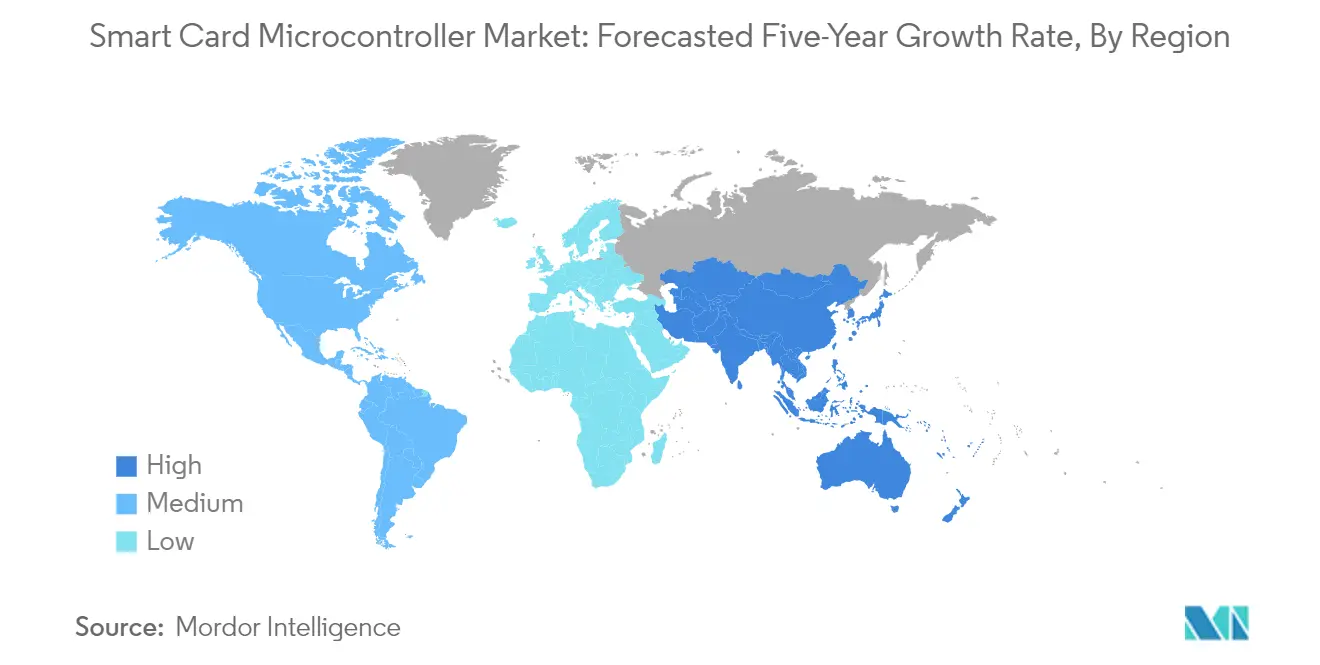
Smart Card Microcontroller Market in Europe
The European smart card MCU market has demonstrated steady progression, recording a growth rate of approximately 4% from 2019 to 2024. The region's market is characterized by its advanced technological infrastructure and strong regulatory framework supporting digital payment solutions. Europe's leadership in implementing smart card microcontroller technology across healthcare, transportation, and government identification systems has established a robust foundation for market growth. The region's emphasis on secure payment solutions and stringent data protection regulations has accelerated the adoption of advanced microcontroller technologies. The presence of major semiconductor manufacturers and continuous technological innovations in smart card solutions has strengthened Europe's position in the global market. The increasing integration of biometric features in payment cards and the growing adoption of contactless payment solutions have created new opportunities for market expansion. Furthermore, the region's focus on developing secure digital identity solutions and the implementation of smart transportation systems continue to drive market growth. The collaborative efforts between financial institutions, technology providers, and government agencies have created a conducive environment for market development.
Smart Card Microcontroller Market in Asia-Pacific
The Asia-Pacific smart card MCU market is positioned for substantial expansion, with a projected growth rate of approximately 6% during the period 2024-2029. The region represents the largest market globally, driven by rapid digitalization initiatives and increasing adoption of smart card technologies across various sectors. The robust growth is supported by government-led digital transformation programs and the expanding financial technology ecosystem. The region's large population base and increasing smartphone penetration have created significant opportunities for smart card applications in mobile payments and digital identification systems. The growing emphasis on secure microcontroller solutions and the implementation of national identification programs have accelerated market development. The presence of major semiconductor manufacturing facilities and continuous technological innovations has strengthened the region's market position. Furthermore, the increasing adoption of smart transportation systems and the integration of smart card solutions in various public services have created multiple growth avenues. The region's dynamic economic environment and rapid urbanization continue to drive the demand for smart card microcontroller solutions.
Smart Card Microcontroller Market in Rest of the World
The Rest of the World region, encompassing the Middle East, Africa, and Latin America, demonstrates growing potential in the smart card microcontroller market. The region's market development is primarily driven by increasing digitalization efforts and the modernization of payment systems. The banking sector's transformation and the implementation of EMV standards have created significant opportunities for market growth. Government initiatives promoting digital identification systems and secure payment solutions have strengthened market development. The telecommunications sector's expansion and the growing adoption of smart card technologies in public transportation systems have diversified market applications. The region's focus on enhancing cybersecurity measures and implementing secure access control systems has accelerated the adoption of smart card solutions. Furthermore, the increasing investments in smart city projects and the development of digital infrastructure continue to create new opportunities for market expansion. The collaboration between international technology providers and local institutions has facilitated knowledge transfer and market development.
Competitive Landscape
Top Companies in Smart Card Microcontroller Market
The smart card microcontroller market is characterized by the presence of established players like NXP Semiconductors, Infineon Technologies, STMicroelectronics, Renesas Electronics, and Microchip Technology leading the innovation landscape. Companies are heavily investing in research and development to enhance their product portfolios, particularly focusing on advanced security features, improved processing capabilities, and energy efficiency. The industry witnesses continuous product launches targeting specific applications across banking, telecommunications, government ID, and transportation sectors. Strategic collaborations between semiconductor manufacturers and smart card producers have become increasingly common to develop integrated solutions. Manufacturing capacity expansion, especially in Asia-Pacific regions, remains a key focus area as companies aim to meet growing demand. Players are also emphasizing sustainability initiatives, with some companies committing to eco-friendly manufacturing processes and recyclable materials in their smart card integrated circuit solutions.
Consolidated Market with Strong Regional Players
The smart card microcontroller market exhibits a relatively consolidated structure dominated by global semiconductor conglomerates with extensive manufacturing capabilities and robust distribution networks. These major players leverage their technological expertise and established relationships with end-users to maintain their market positions. Regional players, particularly in Asia-Pacific, are gaining prominence by focusing on specific application segments and offering customized solutions for local markets. The industry has witnessed strategic acquisitions aimed at expanding product portfolios and gaining access to new technologies, with larger companies acquiring specialized firms to strengthen their market presence.
The competitive dynamics are shaped by long-standing partnerships between semiconductor manufacturers and smart card producers, creating high entry barriers for new entrants. Companies with integrated operations spanning chip design, manufacturing, and security solutions hold significant advantages in the market. The industry structure encourages collaboration between players across the value chain, from raw material suppliers to end-product manufacturers, fostering innovation and standardization in smart card technologies. Market participants are increasingly focusing on vertical integration to maintain control over critical components and ensure quality standards.
Innovation and Security Drive Future Success
Success in the smart card microcontroller market increasingly depends on companies' ability to innovate while maintaining robust security standards. Market leaders are investing in next-generation technologies such as biometric authentication, enhanced encryption capabilities, and improved processing power to address evolving customer needs. The ability to provide comprehensive solutions that combine hardware security with flexible software platforms has become crucial for maintaining market share. Companies are also focusing on developing specialized solutions for emerging applications in mobile payments, digital identification, and Internet of Things (IoT) connectivity.
For contenders looking to gain ground, specialization in specific market segments and regional focus offer viable strategies for growth. The development of cost-effective solutions without compromising security features remains crucial for market expansion in emerging economies. Regulatory compliance, particularly in financial services and government applications, continues to shape product development and market entry strategies. Companies must also address the growing demand for sustainable solutions and enhanced user experience while maintaining stringent security standards. The ability to forge strategic partnerships with technology providers and end-users will remain critical for both established players and new entrants in the market. Notably, the integration of secure microcontroller technologies and smart card microcontroller unit solutions is pivotal in advancing the industry's security capabilities.
Smartcard MCU Industry Leaders
-
NXP Semiconductors N.V.
-
Infineon Technologies AG
-
STMicroelectronics
-
Texas Instruments Incorporated
-
Microchip Technology Inc.
- *Disclaimer: Major Players sorted in no particular order
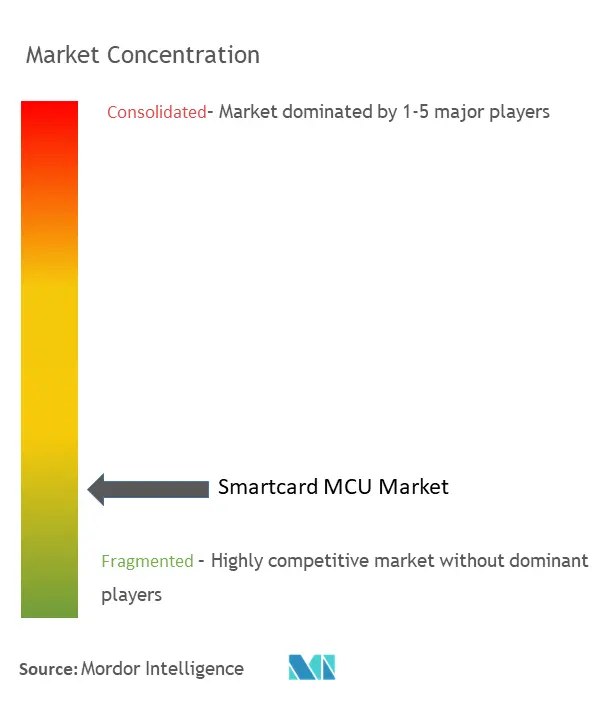
Recent Industry Developments
- April 2023: STMicroelectronics introduced a selection of microcontrollers, which are built on the ARM7 (TM) Thumb(R) core family developed by ARM (LSE: ARM). This new range, known as the STR71xF series, offers a variety of communication interfaces, including I2C, SPI, UART, CAN, USB, HDLC, MMC, and Smart Card interfaces. STMicroelectronics emphasized its established presence in the market for 8- and 16-bit MCUs and expressed its intention to venture into the 32-bit domain with this ARM-based family.
- March 2023 - NXP introduced a new chip that consolidates a microcontroller, an NFC front end, and security into a single IC. The PN7642 facilitates internal key storage and hardware crypto processing, which speeds up secure authentication in hardware, surpassing the speed of a pure software implementation. The PN7642 is highly integrated and customizable, which reduces the size and cost of NFC-based system designs, making an additional MCU optional. The MCU side includes an Arm Cortex M33 core and 180 KB of programmable flash memory.
Global Smartcard MCU Market Report Scope
Smart card microcontrollers are specialized microcontrollers designed to be used in smart cards. These cards are used in a variety of applications, such as payment cards, access control cards, and identification cards. These cards are typically more secure and tamper-resistant than general-purpose microcontrollers as they are often used to store sensitive data, such as financial information or personal identification information.
The smartcard MCU market is segmented by product (8-bit, 16-bit, and 32-bit), by functionality (transaction, communication, security & access control), by end-user industry (BFSI, telecommunications, government and healthcare, education, retail, transportation, and other end-user industries), and by geography (North America, Europe, Asia Pacific, and Rest of the World).
The report offers market sizes and forecasts in value (USD) for all the above segments.
| 8-bit |
| 16-bit |
| 32-bit |
| Transaction |
| Communication |
| Security and Access Control |
| BFSI |
| Telecommunications |
| Government and Healthcare |
| Education |
| Retail |
| Transportation |
| Other End-User Industries |
| North America |
| Europe |
| Asia |
| Australia and New Zealand |
| Latin America |
| Middle East and Africa |
| By Product | 8-bit |
| 16-bit | |
| 32-bit | |
| By Functionality | Transaction |
| Communication | |
| Security and Access Control | |
| By End-user Industry | BFSI |
| Telecommunications | |
| Government and Healthcare | |
| Education | |
| Retail | |
| Transportation | |
| Other End-User Industries | |
| By Geography | North America |
| Europe | |
| Asia | |
| Australia and New Zealand | |
| Latin America | |
| Middle East and Africa |
Key Questions Answered in the Report
How big is the Smartcard MCU Market?
The Smartcard MCU Market size is expected to reach USD 3.50 billion in 2025 and grow at a CAGR of 5.29% to reach USD 4.52 billion by 2030.
What is the current Smartcard MCU Market size?
In 2025, the Smartcard MCU Market size is expected to reach USD 3.50 billion.
Who are the key players in Smartcard MCU Market?
NXP Semiconductors N.V., Infineon Technologies AG, STMicroelectronics, Texas Instruments Incorporated and Microchip Technology Inc. are the major companies operating in the Smartcard MCU Market.
Which is the fastest growing region in Smartcard MCU Market?
Asia Pacific is estimated to grow at the highest CAGR over the forecast period (2025-2030).
Which region has the biggest share in Smartcard MCU Market?
In 2025, the Asia Pacific accounts for the largest market share in Smartcard MCU Market.
What years does this Smartcard MCU Market cover, and what was the market size in 2024?
In 2024, the Smartcard MCU Market size was estimated at USD 3.31 billion. The report covers the Smartcard MCU Market historical market size for years: 2019, 2020, 2021, 2022, 2023 and 2024. The report also forecasts the Smartcard MCU Market size for years: 2025, 2026, 2027, 2028, 2029 and 2030.
Page last updated on:
